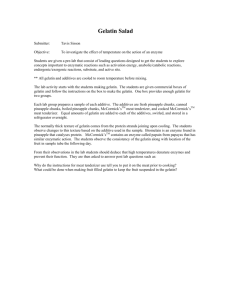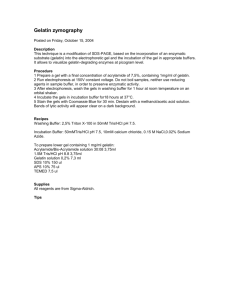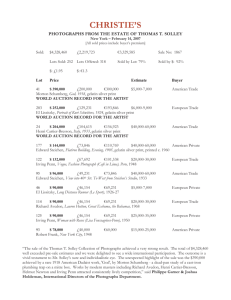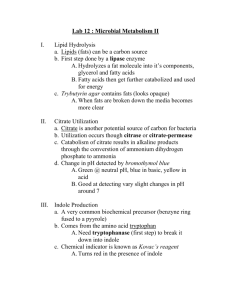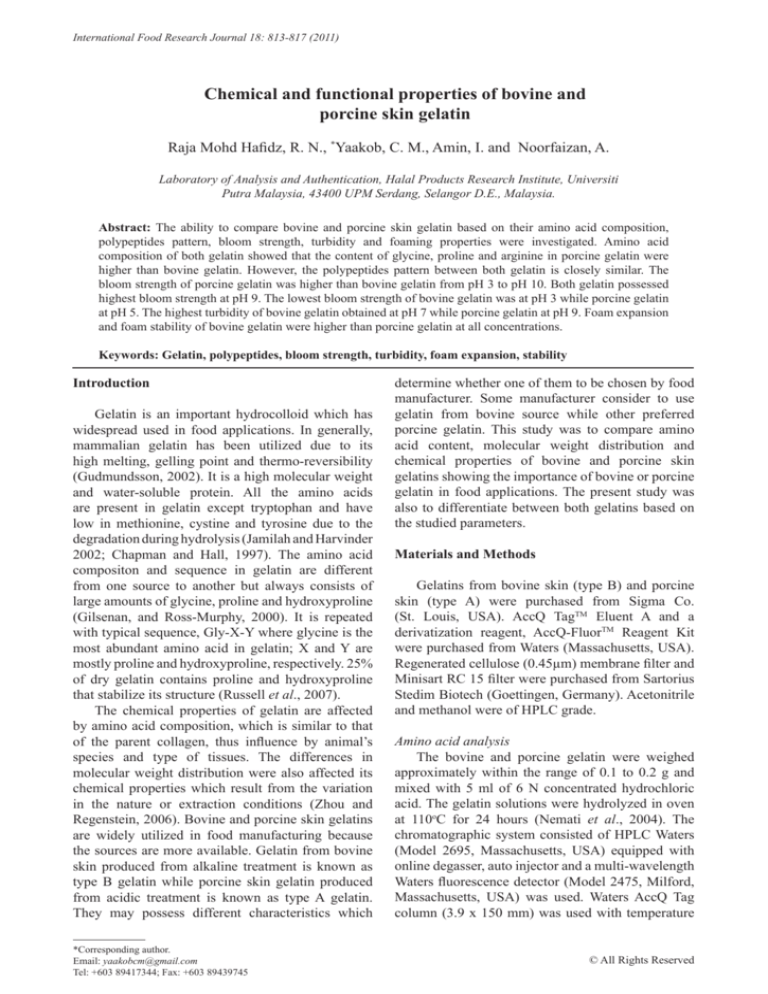
International Food Research Journal 18: 813-817 (2011)
Chemical and functional properties of bovine and
porcine skin gelatin
Raja Mohd Hafidz, R. N., *Yaakob, C. M., Amin, I. and Noorfaizan, A.
Laboratory of Analysis and Authentication, Halal Products Research Institute, Universiti
Putra Malaysia, 43400 UPM Serdang, Selangor D.E., Malaysia.
Abstract: The ability to compare bovine and porcine skin gelatin based on their amino acid composition,
polypeptides pattern, bloom strength, turbidity and foaming properties were investigated. Amino acid
composition of both gelatin showed that the content of glycine, proline and arginine in porcine gelatin were
higher than bovine gelatin. However, the polypeptides pattern between both gelatin is closely similar. The
bloom strength of porcine gelatin was higher than bovine gelatin from pH 3 to pH 10. Both gelatin possessed
highest bloom strength at pH 9. The lowest bloom strength of bovine gelatin was at pH 3 while porcine gelatin
at pH 5. The highest turbidity of bovine gelatin obtained at pH 7 while porcine gelatin at pH 9. Foam expansion
and foam stability of bovine gelatin were higher than porcine gelatin at all concentrations.
Keywords: Gelatin, polypeptides, bloom strength, turbidity, foam expansion, stability
Introduction
Gelatin is an important hydrocolloid which has
widespread used in food applications. In generally,
mammalian gelatin has been utilized due to its
high melting, gelling point and thermo-reversibility
(Gudmundsson, 2002). It is a high molecular weight
and water-soluble protein. All the amino acids
are present in gelatin except tryptophan and have
low in methionine, cystine and tyrosine due to the
degradation during hydrolysis (Jamilah and Harvinder
2002; Chapman and Hall, 1997). The amino acid
compositon and sequence in gelatin are different
from one source to another but always consists of
large amounts of glycine, proline and hydroxyproline
(Gilsenan, and Ross-Murphy, 2000). It is repeated
with typical sequence, Gly-X-Y where glycine is the
most abundant amino acid in gelatin; X and Y are
mostly proline and hydroxyproline, respectively. 25%
of dry gelatin contains proline and hydroxyproline
that stabilize its structure (Russell et al., 2007).
The chemical properties of gelatin are affected
by amino acid composition, which is similar to that
of the parent collagen, thus influence by animal’s
species and type of tissues. The differences in
molecular weight distribution were also affected its
chemical properties which result from the variation
in the nature or extraction conditions (Zhou and
Regenstein, 2006). Bovine and porcine skin gelatins
are widely utilized in food manufacturing because
the sources are more available. Gelatin from bovine
skin produced from alkaline treatment is known as
type B gelatin while porcine skin gelatin produced
from acidic treatment is known as type A gelatin.
They may possess different characteristics which
*Corresponding author.
Email: yaakobcm@gmail.com
Tel: +603 89417344; Fax: +603 89439745
determine whether one of them to be chosen by food
manufacturer. Some manufacturer consider to use
gelatin from bovine source while other preferred
porcine gelatin. This study was to compare amino
acid content, molecular weight distribution and
chemical properties of bovine and porcine skin
gelatins showing the importance of bovine or porcine
gelatin in food applications. The present study was
also to differentiate between both gelatins based on
the studied parameters.
Materials and Methods
Gelatins from bovine skin (type B) and porcine
skin (type A) were purchased from Sigma Co.
(St. Louis, USA). AccQ TagTM Eluent A and a
derivatization reagent, AccQ-FluorTM Reagent Kit
were purchased from Waters (Massachusetts, USA).
Regenerated cellulose (0.45µm) membrane filter and
Minisart RC 15 filter were purchased from Sartorius
Stedim Biotech (Goettingen, Germany). Acetonitrile
and methanol were of HPLC grade.
Amino acid analysis
The bovine and porcine gelatin were weighed
approximately within the range of 0.1 to 0.2 g and
mixed with 5 ml of 6 N concentrated hydrochloric
acid. The gelatin solutions were hydrolyzed in oven
at 110oC for 24 hours (Nemati et al., 2004). The
chromatographic system consisted of HPLC Waters
(Model 2695, Massachusetts, USA) equipped with
online degasser, auto injector and a multi-wavelength
Waters fluorescence detector (Model 2475, Milford,
Massachusetts, USA) was used. Waters AccQ Tag
column (3.9 x 150 mm) was used with temperature
© All Rights Reserved
814
Raja Mohd Hafidz, R. N., Yaakob, C. M., Amin, I. and Noorfaizan, A.
for amino acid separation. The column was set at
36°C, and the injection volume was 5 µl. The AccQ
Tagtm Eluent A concentrate and 60% acetonitrile
were filtered using a 0.45 µm regenerated cellulose
membrane filter prior to injection onto HPLC system.
A flow rate was set at 1 mLmin-1. Waters Empowertm
Pro software was used for data acquisition. The
methodology was referred from Waters AccQ Tagtm
method for hydrolysate amino acid analysis (Astephen
and Wheat, 1993).
Determination of polypeptides pattern
The polypeptides pattern of the gelatins was
determined using a sodium dodecyl sulphatepolyacrylamide gel electrophoresis (SDS-PAGE)
using 4% stacking gel and 12% separating gel
(Laemmli, 1970). The protein concentration of
the samples was determined using Bradford assay
(Bradford, 1976). The gelatin (5 mg/ml) was mixed
with treatment buffer (0.125 M Tris-Cl pH 6.8; 4%
SDS; 20% glycerol, 10% 2-mercaptoethanol) at a
ratio of 1 to 1 (v/v). About 20 µg of proteins were
loaded onto the gel. Electrophoresis was conducted
using a Mini-PROTEAN® Tetra Electrophoresis
System (Bio-Rad Laboratories, Hercules, CA, USA)
at a constant voltage of 150V. Gels were stained using
0.05% Coomassie brilliant blue R250 dissolved in
15% (v/v) methanol and 5% (v/v) acetic acid and
de-stained using a solution containing 30% (v/v)
methanol and 10% acetic acid. The protein marker
(Sigma Co., St. Louis, USA) ranged from 8 to 220
kDa was used.
UV-Vis Hitachi spectrophotometer (Tokyo, Japan).
Determination of foaming properties
Foaming property was measured according the
method described (Aewsiri et al., 2008). BSG and PSG
solutions were prepared at different concentrations (2
to 5% w/v). The mixtures were homogenized for 1 min
at room temperature using a homogenizer at 13500
rpm. The homogenate was allowed to stand for 0 and
30 min. Foam expansion (FE) and foam stability (FS)
were determined using the following equations 1 and
2 where VT is total volume, VO is the original volume
before whipping and Vt is total volume after leaving
at room temperature for different times (30 and 60
min).
FE (%) = VT/VO × 100 (1)
FS (%) = Vt/VO × 100 (2)
Statistical analysis
All measurements on each sample were carried
out in duplicate. Results showed the mean ± standard
deviation and submitted to analysis of variance
(ANOVA) using SPSS Statistics 17.0 (SPSS Inc.,
Chicago, IL). Mean values were compared using the
Duncan’s test at P < 0.05.
Results and Discussion
Determination of gel strength
The bloom strength of BSG and PSG at pH 3
to 10 was determined according to the standard
method (GMIA, 2006). Samples were weighed into
the bloom bottles and dissolved in distilled water
to a final concentration of 6.67% (w/v). The bloom
strength was determined using a texture analyzer
(Stable Micro Systems, Surrey, England) with a 30
kg load cell, equipped with 1.27 cm diameter flatfaced cylindrical plunger. The maximum force (in
grams) taken when the plunger had penetrated 4 mm
onto gelatin gel’s surface, was recorded.
Amino acid composition
The amino acid composition affects the gelatin’s
physical and chemical properties. The amino acid
analysis of gelatin showed molecular structure of
gelatin was different according to composition of
amino acids. Amino acid composition of BSG and
PSG were different especially for glycine, proline
and arginine (Table 1). The amino acid composition
was expressed as residues per 1000 amino acid
residues. Both BSG and PSG had high amount of
glycine followed by proline and arginine. However,
PSG contained higher amount of glycine, proline and
arginine compared to BSG. Both gelatins had low
amount of tyrosine. Histidine was not detected in
both gelatins.
Determination of turbidity
The turbidity of PSG and BSG solution (6.67%
w/v) at different pH (3-10) was determined according
to preferred method (Aewsiri et al., 2008). The
samples were dissolved in distilled water at 60oC
and the pH of solution was adjusted with either 6
N NaOH or HCl. The turbidity was determined by
measuring the absorbance at 360 nm using U-2810
Polypeptides pattern
The polypeptide patterns of BSG and PSG are
shown in Figure 1. The polypeptides bands were
similar for both gelatins. The findings were in
agreement with Gudmundson, 2002. The distinct
bands with molecular weight approximately of
220 and 100 kDa could be represent β and α chain,
respectively. The polypeptides with molecular weight
International Food Research Journal 18: 813-817
Properties of PSG and BSG
below than 100 kDa in BSG and PSG did not obtain
as expected, meaning that the studied gelatins had
high molecular weight protein.
Table 1. Amino acid composition of bovine and porcine
skin gelatin
Amino acid
Nonpolar
hydrophobic
Alanine
Valine
Leucine
Isoleucine
Phenylalanine
Methionine
Proline
Total
Polar uncharged
Glycine
Serine
Threonine
Tyrosine
Total
BSG (residues per
1000 total amino
acid residues)
PSG (residues per
1000 total amino
acid residues)
33
10
12
7
10
4
63
139
80
26
29
12
27
10
151
335
108
15
10
2
135
239
35
26
7
307
17
34
51
41
83
124
11
47
Not detected
58
27
111
Not detected
138
Polar acidic
Aspartic acid
Glutamic acid
Total
Polar basic
Lysine
Arginine
Histidine
Total
BSG: bovine skin gelatin; PSG: porcine skin gelatin; samples were run duplicates; each
involves 2 batches of gelatins.
M
220 kDa
100 kDa
BSG
PSG
β
α
the gelatin close to its isoelectric point, in which the
charge of proteins are more neutral and thus the gelatin
polymers are closer to each other (Gudmundsson and
Hafsteinsson, 1997).
The effect of pH on the bloom strength of BSG
and PSG is shown in Table 2. The strength of BSG and
PSG increased with increasing pH although for PSG,
the strength increased inconsistently. The highest
bloom strength of BSG and PSG were observed at pH
9. The lowest bloom strength of BSG was observed
at pH 3 while for PSG, the lowest bloom strength
at pH 5. Maximal rigidity of porcine gelatin was
achieved at pH 9 while minimum rigidity attained at
pH below 4 and above 10 (Aewsiri et al). The bloom
strength of PSG was higher than that of BSG at all
pHs. It showed the PSG was stiffer than BSG. The
higher bloom strength of PSG as compared to BSG
is due to the high degree of cross-linking and amount
of glycine and proline contained in it. In addition,
the hydrogen bonds between water molecules and
free hydroxyl groups of amino acid will influence
gelatin strength (Arnesen and Gildberg, 2002). From
the results, the high amount of tyrosine and serine
in PSG which had a free hydroxyl group contributes
to the formation of hydrogen bonds which leads to
increased gel strength. The bloom strength is also
said to be affected by the content of hydroxyproline
and molecular weight (Aewsiri et al, 2008).
Table 2. Gel strength of BSG and PSG at different pHs
pH
3
4
5
6
7
8
9
10
60 kDa
45 kDa
815
Force (g)
BSG
193.49 ± 2.09a
234.00 ± 0.46bc
251.03 ± 2.92c
251.40 ± 1.62
266.69 ± 6.67dd
267.63 ± 5.80d
270.35 ± 8.02c
247.09 ± 1.80
PSG
330.57 ± 0.81be
372.95 ± 0.45 a
326.47 ± 0.07d
357.87 ± 1.95c
350.42 ± 1.05 f
389.04 ± 0.29
415.10 ± 1.21gc
348.57 ± 2.36
Different letters within same column denote significant differences (P < 0.05). BSG: bovine
skin gelatin; PSG: porcine skin gelatine. Mean ± SD from duplicate determinations.
30 kDa
20 kDa
Figure 1. Polypeptide patterns of bovine and porcine skin gelatin.
M: protein marker, BSG: bovine skin gelatin; PSG: porcine skin
gelatin; α and β chains: protein component of gelatin.
Effect of pH on gel strength
The gel strength is one of important criteria
which determine the quality of gelatin as required
by manufacturer. It measures the hardness, stiffness,
firmness and compressibility of the gel at a particular
temperature. It is associated with the contents of
proline and hydroxyproline in gelatin. The gel strength
might be dependent on the isoelectric point and could
be controlled by adjusting the pH (Gudmundsson
and Hafsteinsson, 1997). Formation of compact and
stiffer gels can be achieved by adjusting the pH of
Effect of pH on turbidity
The turbidity of BSG and PSG was influenced by
pH as shown in Table 3. BSG had higher turbidity
than that of PSG at all pHs. The turbidity of BSG
was highest at pH 7 and decreased at alkaline pHs.
PSG showed the highest turbidity at pH 9 although
its absorbance was slightly lower at pH 6 and 7.
The maximum turbidity of gelatins occurred at
their isoelectric point (Poppe, 1997). For PSG, its
isoelectric point might be at pH 9, as it showed a
maximum turbidity while for BSG, pH 7 might not
be its pI because BSG was type B alkaline-processed
gelatin. This type of gelatins has isoelectric point
ranged between pH 4.8-5.0 as reported (Aewsiri et al.,
2008). At pH close to isoelectric point, aggregation of
protein molecules occurs and reduces its interaction
with water molecules (Vojdani, 1996).
International Food Research Journal 18: 813-817
Raja Mohd Hafidz, R. N., Yaakob, C. M., Amin, I. and Noorfaizan, A.
816
Table 3. The turbidity of BSG and PSG solutions (6.67%
(w/v)) at different pH
pH
3
4
5
6
7
8
9
Absorbance (360 nm)
BSG
0.919 ±0.003db
1.011 ±0.003 f
1.023± 0.002
1.018 ± 0.002e
1.057 ± 0.002gc
0.932 ± 0.002a
0.903 ± 0.000
PSG
0.055 ± 0.001a
0.065 ± 0.000be
0.078 ± 0.001
0.069 ± 0.001dc
0.073 ± 0.001 f
0.083 ± 0.001
0.087 ± 0.001g
Different letters within same column denote significant differences (P < 0.05). BSG: bovine
skin gelatin; PSG: porcine skin gelatin. Mean ± SD from duplicate determinations.
Determination of foaming properties
Table 4 showed foam expansion (FE) and
foam stability (FS) of BSG and PSG at different
concentrations. FE and FS of BSG and PSG were
increased at concentrations of 2 and 3% (w/v) but
decreased at higher gelatin concentrations (4 and 5%
w/v). Zayas (1997) described that increasing tuna fin
gelatin concentration and porcine skin gelatin (%w/v)
lead to the increased of FE and FS. This complies
with the results presently obtained. However, the
reduced value of FE and FS at 4 and 5% (w/v)
PSG and BSG concentration is might be due to the
improper homogenization of the gelatin. In overall,
FE and FS of BSG were higher than PSG at all tested
concentrations (%w/v).
Table 4. The foaming properties of bovine and porcine skin
gelatin at different concentrations
Concentration of
gelatin (%)
FE (%)
FS (%)
0 min
30 min
BSG (2%)
93.00 ± 2.65b
91.67 ± 3.21b
(3%)
94.67 ± 1.53
b
93.67 ± 1.53b
(4%)
91.00 ± 1.00b
89.33 ± 1.53b
(5%)
72.33 ± 5.51
a
86.50 ± 5.51a
PSG (2%)
90.00 ± 1.00c
87.67 ± 2.08c
(3%)
(4%)
93.00 ± 1.00c
70.00 ± 10.44b
88.67 ± 2.52c
68.33 ± 9.29b
(5%)
53.00 ± 1.00a
51.33 ± 0.58a
Different letters in the same column within the same gelatin denote significant differences
(P<0.05). FE: foam expansion; FS: foam stability. Mean ± SD from duplicate determinations.
FS of BSG and PSG decreased when incubation
time increased because during foam ageing,
gravitational forces might cause water to drain
and air cells came closer together. High viscosity
at higher concentrations was useful in preventing
gravity deformation of the film in protein foams.
The bulk viscosity of BSG and PSG affected the
FS which in turn extends the the stability of foams.
Foaming properties of protein could be influenced
by protein source, intrinsic properties of protein,
the compositions and conformation of the protein
in solution and at the air/ water interface (Zayas,
1997).
Conclusions
The bovine and porcine skin gelatin could be
distinguished based on amino acid composition in
which the glycine and proline of PSG were higher
than BSG. In addition, the gel strength of PSG is
higher than BSG while the foaming properties of
BSG are more stable than PSG. Maximum turbidity
of BSG was achieved at pH 7; in contradict with PSG
that achieves it maximum turbidity at pH 9. However,
the polypeptides pattern of both gelatin could not be
differentiated using one dimensional electrophoresis
(SDS-PAGE). PSG that has high bloom strength is
suitable to be used in the production of jellied meats
and marshmallow. Both PSG and PSG are also
used as foam stabilizer like has been exploited in
marshmallows industry. Low Bloom strength BSG is
also suitable for used as clarifying agent in fruit juice
products.
Acknowledgements
The authors greatly appreciate the financial
support by Universiti Putra Malaysia under Research
University Grant Scheme (RUGS 91031).
References
Aewsiri, T., Benjakul, S., Vinessanguan, W. and Tanaka,
M. 2008. Chemical compositions and functional
properties of gelatin from pre-cooked tuna fin.
International Journal of Food Science and Technology
43: 685-693.
Arnesen, J. A. and Gildberg, A. 2002. Preparation and
characterization of gelatin from the skin of harp seal
(Phoca groendlandica). Bioresource Technology 82:
191–194.
Astephen, N. and Wheat, T. 1993. An amino acid analysis
method for assessing nutritional quality of infant
formulas. American Laboratory: T162.
Bradford, M. M. 1976. A refined and sensitive method
for the quantitation of microgram quantities of
protein utilizing the principle of protein-dye binding.
Analytical Biochemistry 72: 248.
Chapman and Hall 1997. Thickening and gelling agents for
food, 2nd edition, Blackie Academic & Professional,
London, pp. 150-153.
Gelatin Manufacturer’s Institute of America, inc. (GMIA)
revised 2006. Standard methods for the testing of
edible gelatin. Gelatin Manufacturers Institute of
America, Inc.
Gilsenan, P.M. and Ross-Murphy, S.B. 2000. Rheological
characterisation of gelatins from mammalian and
marine sources. Food Hydrocolloids 14: 191-195.
Gudmundsson, M. 2002. Rheological properties of fish
gelatin. Journal of Food Science 67 (6): 2172-2176
Gudmundsson, M. and Hafsteinsson, H. 1997. Gelatin
from cod skins as affected by chemical treatments.
Journal of Food Science 62: 37–39
Jamilah, B. And Harvinder, K.G. 2002. Properties of
International Food Research Journal 18: 813-817
Properties of PSG and BSG
gelatins from skins of fish-black tilapia (Oreochromis
mossambicus) and red tilapia (Oreochromis nilotica).
Food Chemistry 77: 81-84
Laemmli, U.K. 1970. Cleavage of structural proteins
during assembly of head of bacteriophage T4. Nature
277: 680-685
Nemati, M; Oveisi, M. R.; Abdollahi, H. and Sabzevari, O.
2004. Differentiation of bovine and porcine gelatins
using principal component analysis. Journal of
Pharmaceutical and Biomedical Analysis 34: 485-492
Poppe, J. Gelatin 1997. In Thickening and Gelling Agents
for Food, 2nd edition. London: Blackie Academic and
Professional; 144–168.
Russell, J. D.; Dolphin, J. M. and Koppang, M. D. 2007.
Selective analysis of secondary amino acids in gelatin
using pulsed electrochemical detection. Analytical
Chemistry 79: 6615-6621.
Vojdani, F. 1996. Solubility. In Methods of Testing Protein
Functionality, 1st edition, Bury St.Edmunds Press : St
Edmundsbury: 11–60.
Zayas, J.F. 1997. Solubility of proteins. In Functionality of
Proteins in Food, Berlin: Springer-Verlag; 6-22.
Zhou, P. and Regenstein, J. M. 2006. Determination of
total protein content in gelatin solutions with the
Lowry or Biuret Assay. Journal of Food Science 71
(8), 474-479.
International Food Research Journal 18: 813-817
817

